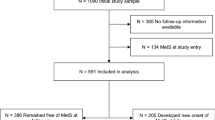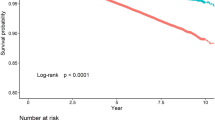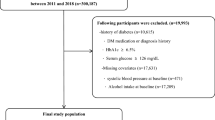Abstract
Objective:
To examine associations between current recommended physical activity levels and body mass index (BMI) with some cardiovascular disease (CVD) risk factors (total cholesterol, high-density lipoprotein cholesterol (HDL-C), non-HDL-cholesterol (non-HDL-C), C-reactive protein (CRP), fibrinogen, and blood pressure), general health score (GHQ12) and predicted coronary heart disease (CHD) risk.
Design:
Further analysis of the cross-sectional Scottish Health Survey 1998 data.
Subjects:
Five thousand four hundred and sixty adults 16–74 years of age.
Results:
After controlling for some confounding factors, obesity was significantly associated with higher odds ratio (OR) for elevated cholesterol, CRP, systolic blood pressure, non-HDL-C and lower HDL-C (P<0.001), and with greater predicted CHD risk compared to BMI <25 kg/m2. Regular self-reported physical activity was associated with smaller OR of lower HDL-C and higher CRP, and average predicted 10-year CHD risk in obese subjects, but did not eliminate the higher risk of the measured CVD risk factors in this group. The OR of these two risk factors were still high 4.39 and 2.67, respectively, when compared with those who were inactive with BMI <25 kg/m2 (P<0.001). Those who reported being physically active had better GHQ scores in all BMI categories (P<0.001).
Conclusion:
Reporting achievement of recommended physical activity levels may reduce some CVD risk factors, predicted CHD risk and improve psychosocial health, but may not eliminate the extra risk imposed by overweight/obesity. Therefore, increasing physical activity and reducing body weight should be considered to tackle CVD risk factors.
This is a preview of subscription content, access via your institution
Access options
Subscribe to this journal
Receive 12 print issues and online access
$259.00 per year
only $21.58 per issue
Buy this article
- Purchase on Springer Link
- Instant access to full article PDF
Prices may be subject to local taxes which are calculated during checkout





Similar content being viewed by others
References
American College of Sports Medicine (1990). American College of Sports Medicine position stand. The recommended quantity and quality of exercise for developing and maintaining cardiorespiratory and muscular fitness in healthy adults. Med Sci Sports Exerc 22, 265–274.
Blair SN, Brodney S (1999). Effects of physical inactivity and obesity on morbidity and mortality: current evidence and research issues. Med Sci Sports Exerc 31, S646–S662.
Blair SN, Cheng Y, Holder JS (2001). Is physical activity or physical fitness more important in defining health benefits? Med Sci Sports Exerc 33, S379–S399. ; discussion S419–S420.
Blair SN, Church TS (2004). The fitness, obesity, and health equation: is physical activity the common denominator? JAMA 292, 1232–1234.
Blair SN, Connelly JC (1995). How much physical activity ahould we do? The case for moderate amounts and intensities of physical activity. In Moving On: International Perspectives on Promoting Physical Activity A killoran, N Cavill, A Walker (eds). London: Health Education Authority.
Caspersen CJ, Powell KE, Christenson GM (1985). Physical activity, exercise, and physical fitness: definitions and distinctions for health-related research. Public Health Rep 100, 126–131.
Christou DD, Gentile CL, DeSouza CA, Seals DR, Gates PE (2005). Fatness is a better predictor of cardiovascular disease risk factor profile than aerobic fitness in healthy men. Circulation 111, 1904–1914.
Church TS, Cheng YJ, Earnest CP, Barlow CE, Gibbons LW, Priest EL et al (2004). Exercise capacity and body composition as predictors of mortality among men with diabetes. Diabetes Care 27, 83–88.
Dunn AL, Trivedi MH, Kampert JB, Clark CG, Chambliss HO (2005). Exercise treatment for depression: efficacy and dose response. Am J Prev Med 28, 1–8.
Goldberg DP, Williams P (1988). A User's Guide to the General Health Questionnaire. Windsor: NFER/Nelson.
Grundy SM (2002). Approach to lipoprotein management in 2001 National Cholesterol Guidelines. Am J Cardiol 90, 11i–21i.
Hassan MK, Joshi AV, Madhavan SS, Amonkar MM (2003). Obesity and health-related quality of life: a cross-sectional analysis of the US population. Int J Obes Relat Metab Disord 27, 1227–1232.
Hu FB, Willett WC, Li T, Stampfer MJ, Colditz GA, Manson JE (2004a). Adiposity as compared with physical activity in predicting mortality among women. N Engl J Med 351, 2694–2703.
Hu G, Lindstrom J, Valle TT, Eriksson JG, Jousilahti P, Silventoinen K et al. (2004b). Physical activity, body mass index, and risk of type 2 diabetes in patients with normal or impaired glucose regulation. Arch Intern Med 164, 892–896.
Katja B, Laatikainen T, Salomaa V, Jousilahti P (2006). Associations of leisure time physical activity, self-rated physical fitness, and estimated aerobic fitness with serum C-reactive protein among 3,803 adults. Atherosclerosis 185, 381–387.
Katzmarzyk PT, Church TS, Blair SN (2004). Cardiorespiratory fitness attenuates the effects of the metabolic syndrome on all-cause and cardiovascular disease mortality in men. Arch Intern Med 164, 1092–1097.
Katzmarzyk PT, Church TS, Janssen I, Ross R, Blair SN (2005). Metabolic syndrome, obesity, and mortality: impact of cardiorespiratory fitness. Diabetes Care 28, 391–397.
LaMonte MJ, Barlow CE, Jurca R, Kampert JB, Church TS, Blair SN (2005). Cardiorespiratory fitness is inversely associated with the incidence of metabolic syndrome: a prospective study of men and women. Circulation 112, 505–512.
Lean ME, Anderson AS, Morrison C, Currall J (2003). Evaluation of a dietary targets monitor. Eur J Clin Nutr 57, 667–673.
Meyer HE, Sogaard AJ, Tverdal A, Selmer RM (2002). Body mass index and mortality: the influence of physical activity and smoking. Med Sci Sports Exerc 34, 1065–1070.
NCEP (2001). Executive Summary of The Third Report of The National Cholesterol Education Program (NCEP) Expert Panel on Detection, Evaluation, And Treatment of High Blood Cholesterol In Adults (Adult Treatment Panel III). JAMA 285, 2486–2497.
Pate RR, Pratt M, Blair SN, Haskell WL, Macera CA, Bouchard C et al. (1995). Physical activity and public health. A recommendation from the Centers for Disease Control and Prevention and the American College of Sports Medicine. JAMA 273, 402–407.
Peluso MA, Andrade LH (2005). Physical activity and mental health: the association between exercise and mood. Clinics 60, 61–70.
Schmitz N, Kruse J, Kugler J (2004). The association between physical exercises and health-related quality of life in subjects with mental disorders: results from a cross-sectional survey. Prev Med 39, 1200–1207.
Shaw A, Mcmunn A, Field J (eds) (2000). The Scottish Health Survey 1998 Joint Health Survey Unit, at the National Centre for Social Research and Department of Epidemiology and Public Health.. London: UC.
Stephens T (1988). Physical activity and mental health in the United States and Canada: evidence from four population surveys. Prev Med 17, 35–47.
Stevens J, Cai J, Evenson KR, Thomas R (2002). Fitness and fatness as predictors of mortality from all causes and from cardiovascular disease in men and women in the lipid research clinics study. Am J Epidemiol 156, 832–841.
Stevens J, Evenson KR, Thomas O, Cai J, Thomas R (2004). Associations of fitness and fatness with mortality in Russian and American men in the lipids research clinics study. Int J Obes Relat Metab Disord 28, 1463–1470.
The Scottish Office (1996). Eating for Health: A Diet Action Plan for Scotland. Edinburgh: The Scottish Office Department of Health, HMSO.
Weinstein AR, Sesso HD, Lee IM, Cook NR, Manson JE, Buring JE et al. (2004). Relationship of physical activity vs body mass index with type 2 diabetes in women. JAMA 292, 1188–1194.
Wessel TR, Arant CB, Olson MB, Johnson BD, Reis SE, Sharaf BL et al. (2004). Relationship of physical fitness vs body mass index with coronary artery disease and cardiovascular events in women. JAMA 292, 1179–1187.
WHO (1998). Obesity: Preventing and Managing the Global Epidemic Report of a WHO Consultation on Obesity. June 3–5, 1997. Geneva: WHO.
WHO (2001). The World Health Report 2001: Mental Health: New Understanding, New Hope. Geneva: WHO.
WHO (2003a). Diet, Nutrition and the Prevention of Chronic Diseases. Report of a Joint WHO/FAO Expert Consultation. Geneva: WHO.
WHO (2003b). Health and Development through Physical Activity and Sport. Geneva: WHO.
Wilson PW, D'Agostino RB, Levy D, Belanger AM, Silbershatz H, Kannel WB (1998). Prediction of coronary heart disease using risk factor categories. Circulation 97, 1837–1847.
Acknowledgements
Mehdi Akbartabartoori was funded by Islamic Republic of Iran. The authors thank the Scottish Health Survey Group for access to their data.
Author information
Authors and Affiliations
Corresponding author
Additional information
Guarantor: Dr M Akbartabartoori.
Contributors: MA designed the study, completed the statistical analysis and prepared the draft under supervision of both CRH and MEJL. Both CRH and MEJL participated in developing the study design. All authors approved the final version.
Rights and permissions
About this article
Cite this article
Akbartabartoori, M., Lean, M. & Hankey, C. The associations between current recommendation for physical activity and cardiovascular risks associated with obesity. Eur J Clin Nutr 62, 1–9 (2008). https://doi.org/10.1038/sj.ejcn.1602693
Received:
Revised:
Accepted:
Published:
Issue Date:
DOI: https://doi.org/10.1038/sj.ejcn.1602693
Keywords
This article is cited by
-
The role of lifestyle and non-modifiable risk factors in the development of metabolic disturbances from childhood to adolescence
International Journal of Obesity (2020)
-
Effectiveness of the physical activity promotion programme on the quality of life and the cardiopulmonary function for inactive people: Randomized controlled trial
BMC Public Health (2013)
-
Changes in BMI and waist circumference in Scottish adults: use of repeated cross-sectional surveys to explore multiple age groups and birth-cohorts
International Journal of Obesity (2013)



